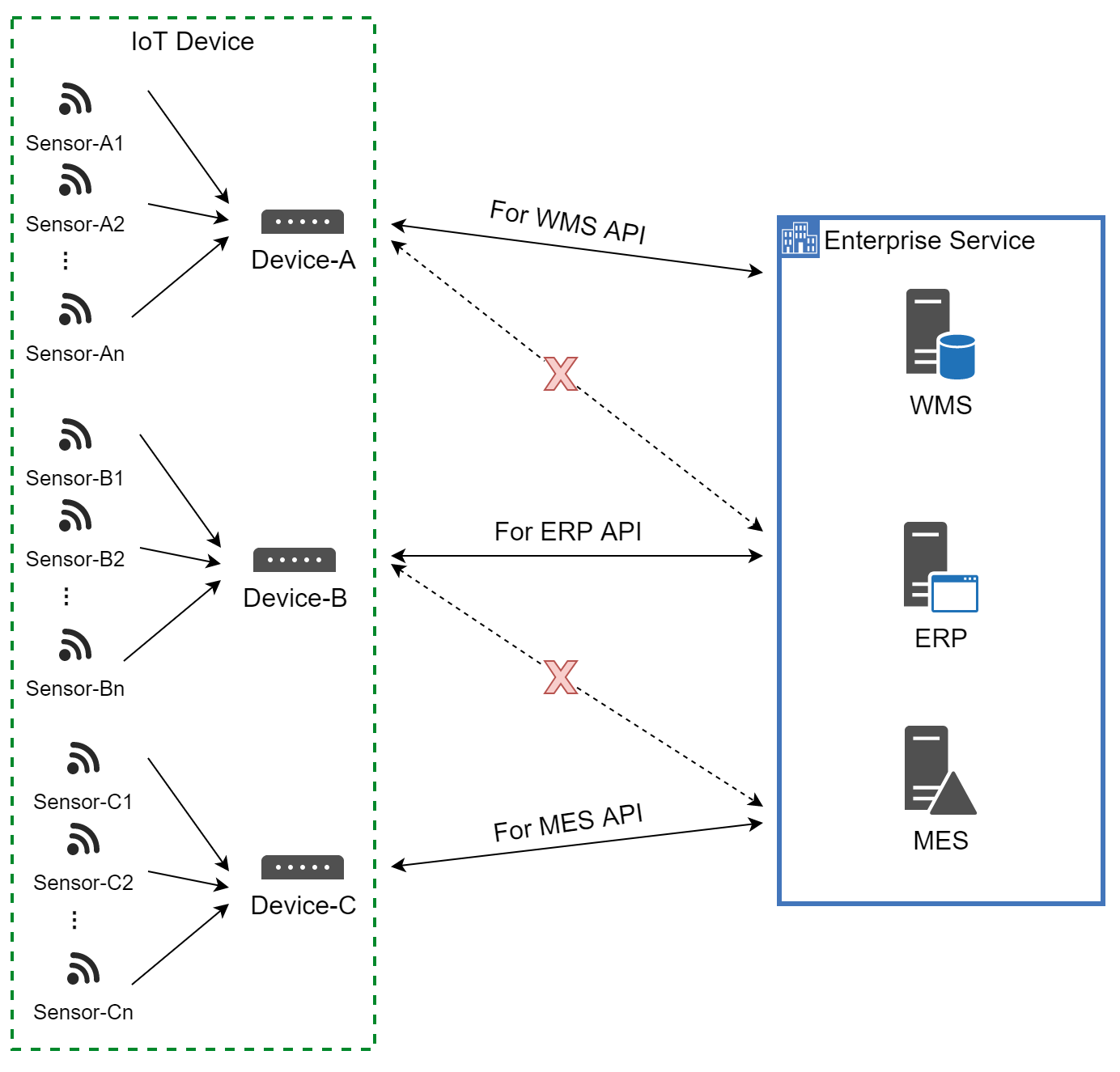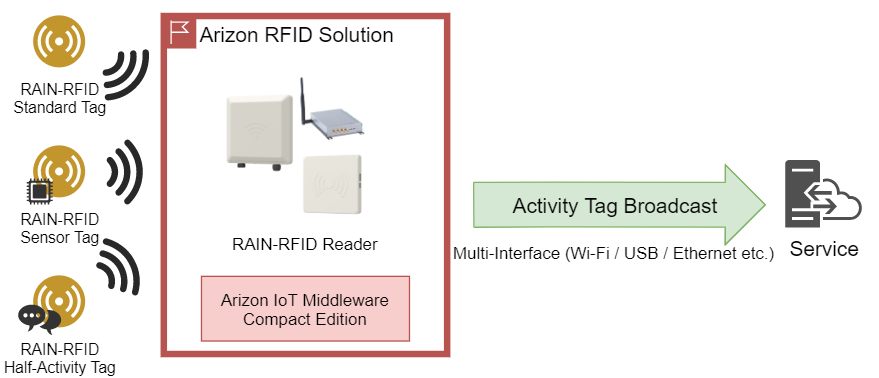Middleware - The bridge between IoT infrastructure and enterprise application system
I. The most frequently encountered problems in IoT
IoT application systems are highly complex, and how to reduce the integration barriers and save cost is a key factor for successful IoT implementation.
In the IoT field, we need to solve many problems, such as domain knowledge, data flow, RF signal problems system integration problems. Most system integration companies need to support from IoT equipment suppliers to lower the barriers to integration issues. System integration companies need to integrate a variety of different IoT devices in the IoT project, such as RFID reader, coordinator, gateway, etc. This article will share the role of IoT RFID devices and middleware in system integration.

Figure 1. Basic architecture of IoT and RFID
II. What is middleware
Middleware is a service software between IoT hardware (RFID reader, coordinator, gateway) and enterprise application process systems (ERP, WMS, POS, etc.), it is also called glue software. The main purpose is to lower the barriers of device integration when implementing IoT solutions/applications.
Middleware includes several functions:
1. Device control and monitor
Through different communication protocol control methods (Network Socket, Web API/ Service, MQTT, RESTful API, etc.) to connect with the IoT device in the application environment and monitor the device status and communicate through software control methods.
2. Data collection and filtering
Collect data from Device and IoT tags (RAIN RFID Tag or End Device) through various IoT control methods, such as software protocols, commands, SDKs, etc., and filter incomplete data packets.
3. Ensure the data accuracy for the services
When data is collected from multiple RFID readers to the middleware, it will check the data and makes data accurate, provide the data/information to the client software (enterprise application process system), and establish a unified data handshaking method and format.
4. Device monitoring
The existence of middleware eliminates the need for enterprise application software to connect and control IoT devices on its own. Middleware plays a role in device connection and device status monitoring, and can send data to clients and devices for troubleshooting.
III. Benefits and features of middleware
The concept of IoT/RFID middleware has been developed for many years. The RFID was first established in the C1Gen2 architecture framework defined by EPC Global. ALE server was used to describe the outline of the middleware. ALE middleware uses ROSpec and ROReport messages as the communication between RFID reader and EPCIS for supporting LLRP, the content is complete but too complicated.
Afterward, in order to jostle for a slice of the IoT software market, the world’s software giants added IoT middleware service systems to their existing software service platforms. (For example, early IBM's WebSphere, Oracle Sensor Edge Server, and Microsoft's BizTalk Server, and so on RFID solutions).
The benefits of middleware:
1. Turn complex integration architecture into simple: For example, when multiple IoT devices need to serve multiple systems, middleware can be used to integrate multiple IoT devices or RAIN RFID readers, and you can also use this software to serve multiple client/server application services, turning the many-to-many complex connection structure into two simple one-to-many connection structures.
2. Message filtering and delivery coordination: Due to the middleware, the applications (ERP, WMS, AMS, etc.) do not need to receive meaningless RAIN RFID tag or IoT ED information, and middleware will deliver the services according to the code rules, which reduces the time and cost for enterprise systems to process IoT raw data.
3. Support a variety of devices and expansion: the scalability of the device is managed and deployed by middleware, eliminating the demand for IoT device extensions and modifications in the application when adding IoT devices or readers.
However, the current middleware system also has the same disadvantages, the current middleware systems on the market have common features:
1. Complex system: Many IoT Middleware platforms provided by major software companies are based on their existing products to expand.
2. Service is not focused on certain field: Major software companies do not focus on the IoT industry as their main development axis scheme, they need IoT device suppliers to support and integrate into the platform.
3. Import cost (selling price) is too high: Equipped with existing software platform system, therefore, Middleware may be sold with other services and databases, resulting in high import costs.
4. Facing issues such as product EOL: Many companies often make major adjustments to their existing IoT Device integration portal due to cloud service architecture requirements, resulting in limited edition or no-service systems of the product.
5. The maintenance cost is extremely high: Middleware originally aimed to lower the integration barriers, as a result, the middleware service has an overly complex software architecture,leading to when problems such as IoT/RFID occur, It barriers need to be eliminated, too many integrated interfaces and network nodes make it difficult to eliminate barriers. Cause a situation that cannot be recovered quickly.
.png)
Figure 2. Complex IoT/RFID architecture
IV. Embedded in reader middleware and URC
Arizon's role in the IoT value chain is a provider of RAIN RFID and IoT solutions. In the past, professional investment in middleware was very deep. The service types of middleware are mainly based on web API/Windows, these are the type of upper-level application software as middleware.
Starting in 2020, we have re-improved the middleware service architecture. We moved the middleware from the x86 platform to the RFID reader, making it an RFID Reader with a built-in middleware.
We provide two methods to build the middleware in RFID reader:
1. The software service structure, data format, and data transformation can be defined before delivering.
2. Open commands to provide users with the ability to quickly build middleware so that RFID reader can work autonomously.
Reader with embedded Middleware has several advantages:
1. The reader can be easy to use the service without complicated steps
2. Provide a reliability system handshake method and quickly integrate it into the required system.
3. Low construction and maintenance costs, at an affordable price and high scalability.When it is encountering an abnormal situation, other there is no server or workstation between the RFID middleware, and thus a lot of physical network nodes (the back-end to the PC, the PC to the reader wire) and software integration nodes are streamlined that makes difficult to remove barriers. Arizon can quickly troubleshoot this situation, ensure the connection quality, the correctness of the data, and the quick recovery system.
4. Free middleware client source code (C# and net, others software language coming soon)
Figure 3. Middleware embedded in RAIN RFID Reader
Arizon’s AL-510 RFID reader, AL-400, AL-410 RFID reader, and many other RAIN RFID readers have embedded RFID middleware compact edition system services as a client. This technology utilizes the auto reader mode in the IoT reader middleware to actively transfer data. By setting the learning command to the reader, you only need to power up the RFID reader, and the data can be directly sent to the receive application. Without complicated commands, it is the easiest integrated IoT device and RAIN RFID reader for integration in the industry.
Tina Chueh Jun. 17,2021





